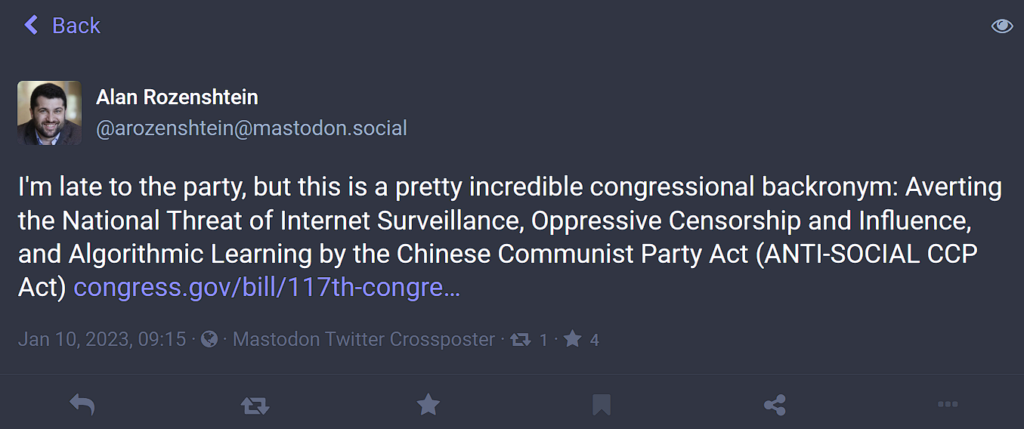Earlier this week, I had a meeting with the supervisory team for the capstone project for my Masters in Community Development program at the University of Victoria. We talked a lot about how my advisor helped me narrow the scope of the project to something that was accomplishable in the remaining time I had in my program; this in turn has prompted me to ponder the talking points for a recruitment and feedback presentation I hope to give at a public school board meeting and other places about my research project.
While browsing my Mastodon federated timeline, I came across this social media post by Alan Rozenshtein, an associate professor at the law school of the University of Minnesota. He was amused by the title of a recently proposed United States law because the title resulted in a pretty egregious use of initialism:

Here is what I think is bad about how part of this bill (which was sponsored by Florida Senator Marco Rubio) was drafted, and this will include a fair amount of pedantry.
Section 2.b.1.A uses the term “country of concern” for the first time and the phrase as a whole is repeated 16 times in total. Sounds like an important term of art to define, right? Luckily there is a section of all bills where terms of art are defined, and this term is defined in Section 2.f.1, seen below as Figure 2.

(S.5245 – 117th Congress [2021-2022], 2022)
Section 2.f.1.A contains a hyperlink to the text of the Secure and Trusted Communications Networks Act of 2019 (47 U.S.C. 1607(c)(2)). I assume that’s where the phrase “country of concern” originated, so let’s follow the hyperlink and search for the phrase “country of concern”. So what do I see when I click on the link in Sen. Rubio’s bill? When I do a Ctrl-F search for the phrase “country of concern”, there is no such phrase in this law.
“Ah,” you say, “but the text in S. 5245 says that the phrase country of concern ‘has the meaning’ of the term foreign adversary, and that term is located three times in the Secure and Trusted Communications Networks Act of 2019! And that term is well-defined as ‘any foreign government or foreign nongovernment person engaged in a long-term pattern or serious instances of conduct significantly adverse to the national security of the United States or security and safety of United States persons.'”
My response to this hypothetical rebuttal is, “Why didn’t Sen. Rubio just use the phrase foreign adversary in his bill if it has not only been previously well-defined in a bill which is now law, but also the phrase foreign adversary itself is concrete enough for someone who isn’t a U.S. Congressional attorney to understand?”
In legislation or a set of policy and regulations documents, I believe that terms of art need to be properly defined either through an explicit definition or an example which places the term in a context which can be read and understood by the average person. This is such an important part of drafting U.S. legislation that it was the first piece of advice offered by Medows in a 2016 article for the Harvard Journal on Legislation:
When you draft legislation, state exactly what needs to be said in the most straightforward manner possible. Do not worry about dazzling the reader with your erudite diction and impressive caliber of jargon; if you must, you can save that for some other forum, like a cocktail party.
(Medows, 2016)
This advice is not new; it was considered a fundamental component in legislative drafting as evidenced by this address given during the first meeting of the Bill Drafting Conference in Chicago a century prior:
There may be some who look upon the purely external phases of bill drafting asked in different detail with regard to which it is not worthwhile to disturb established conventions, though concededly capable of improvement: I refer particularly to the long and involved sentences which are the fashion in acts of Congress. But a moment’s reflection will show that this is by no means a matter of indifference; for complexity of phraseology is a very substantial hindrance to effective criticism and debate while the bill is under construction….
(Freund, 1916)
When governance documents are only readable and comprehensible by a few people who have the specialized training in how to read them, it excludes so much of the population who do not have the time, ability, inclination, resources, or preference to gain that kind of specialized training. This applies not just to laws, but also school board regulations, workplace agreement contracts, memorandums of understanding, research agreements, etc.
In closing, that is part of what I hope to gain from conducting my Master’s research project: an insight into how parents read (or don’t read) strategic planning governance documents from their kids’ school district, and what would help them be more willing to take the time to read them, become familiar with them, and support the initiatives which come forth from those strategic plans.
References
Freund, E. (1916). Legislative Drafting: Address delivered at the first annual meeting of the Bill Drafting Conference, Chicago, Illinois, August 29, 1916. The Making of Modern Law: Legal Treatises, 1800–1926. https://link.gale.com/apps/doc/F0152394045/MOML?sid=bookmark-MOML&xid=14eb865b&pg=8
Medows, D. B. (2016, October 24). A Beginner’s Guide to Legislative Drafting. Harvard Journal on Legislation. https://harvardjol.com/2016/10/24/a-beginners-guide-to-legislative-drafting
“United States Capitol Building Sunrise 2nd Inauguration 2013 Washington D.C.” by Anthony Quintano is licensed under CC BY 2.0.
